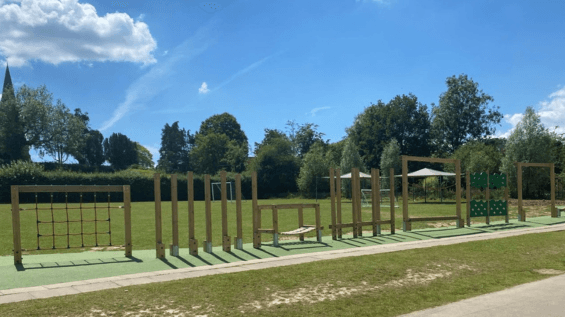
Sep

How Trim Trails Support Physical Development and Fun in Schools
Schools across the UK are increasingly looking for ways to enhance their play spaces with equipment that supports both learning and physical development. One of the most popular choices in recent years has been the installation of trim trails.
Trim trails are adventure-style play routes that combine balance beams, stepping logs, and climbing features to build children’s strength, coordination, and confidence. Popular in schools, they promote daily activity, teamwork, and imaginative play. Flexible, safe, and inclusive, trim trails help pupils of all ages develop essential physical and social skills.
This investment is well aligned with the demand from pupils themselves. According to the Youth Sport Trust’s annual report in 2025, 71 percent of pupils said they wanted to be more active in school, and 96 percent of teachers agreed that sport and play have a positive effect on mental wellbeing¹. Trim trails directly respond to this demand by bringing activity and play into everyday school life.
What Are Trim Trails?
Trim trails are sequences of linked play and fitness features that create an adventure-style pathway across a playground or field. They can include stepping logs, balance beams, rope traverses, climbing walls, net climbs, monkey bars, or wobbly bridges.
Their design allows schools to combine different challenges into one continuous trail or break them up into smaller circuits that suit the space available. This makes them highly adaptable for Early Years Foundation Stage (EYFS), Key Stage 1, and Key Stage 2 environments.
Children experience trim trails as fun and adventurous, but at the same time, they are building strength, coordination, and confidence. They are deliberately designed to provide varied levels of challenge, meaning a school can choose features that are age-appropriate while still offering progression as pupils grow older.
Physical Development Benefits
Balance, Coordination, and Motor Skills
Trim trails are excellent for building physical foundations that support lifelong activity. Features such as balance beams and stepping logs help pupils develop coordination and spatial awareness. Rope traverses and climbing nets enhance core stability and grip strength. Together, these experiences contribute to improved gross motor skills, which are essential for everything from sports to handwriting.
Trim trails are more than a fun way to play. As children climb, balance, and move along the equipment, they naturally learn how to control their bodies, improve coordination, and grow more confident in how they move.
Building Active Habits
In many schools, PE lessons do not provide enough minutes of physical activity to meet daily guidelines. The World Health Organization and UK Government recommend that children complete at least 60 minutes of moderate to vigorous activity each day, with 30 minutes of that taking place during school hours. However, the Youth Sport Trust has highlighted that a third of pupils are not achieving the in-school 30-minute activity target¹.
Trim trails make it easier for schools to integrate movement throughout the day. Pupils can use them during break times, before or after lessons, or as part of structured circuits in PE. By embedding physical activity into the fabric of the playground, schools give children more opportunities to develop healthy and sustainable habits.
Confidence and Risk Management
Trim trails also provide a safe way for children to explore risk. Completing a rope traverse or climbing over a log balance teaches resilience, decision-making, and persistence. Ofsted’s school inspection framework emphasises the importance of building character and resilience, and trim trails provide an environment where these qualities can be nurtured through play.
The Fun and Social Benefits of Trim Trails
Imaginative and Creative Play
Children naturally use trim trails as adventure courses. One day, they might be crossing a jungle bridge, the next, they are navigating an army-style training ground. This imaginative play stimulates creativity while keeping them active.
Teamwork and Collaboration
Trim trails are also a social hub. Pupils challenge each other to complete routes, take turns, or create group games that involve teamwork. The Youth Sport Trust reports that schools delivering regular opportunities for play and activity see improved self-belief and teamwork skills¹. For teachers and school leaders, this means that trim trails are contributing not only to physical health but also to personal and social education.
Inclusive Play for All Pupils
Trim trails can be designed with varying levels of difficulty, making them accessible to a wide range of abilities. Lower stepping logs and wide balance beams provide easy access, while rope climbs and monkey bars challenge more confident pupils. This flexibility supports inclusion for children with different levels of physical confidence and is particularly valuable for SEND pupils who may need a mix of accessible and progressive activities.
Why Trim Trails Are Ideal for School Play Spaces
Flexible and Space Efficient
Trim trails are highly versatile. Schools with smaller playgrounds can install compact routes, while larger schools can create expansive trails. Their modular design means schools can start with a few features and expand over time as budgets allow.
Curriculum and Play Integration
Trim trails are not limited to break and lunch times. They can be built into the curriculum by being used for warm-ups in PE, obstacle course races, or Daily Mile alternatives. Teachers can even use them for cross-curricular activities such as counting jumps in maths or storytelling exercises.
The UK Government’s School Sport and Activity Action Plan recommends embedding activity throughout the school day, and trim trails provide a direct, low-maintenance way to achieve this².
Affordable and Equitable Access
The Youth Sport Trust’s 2025 report highlighted that the cost-of-living crisis has reduced access to extra-curricular sport for many families¹. In this context, on-site activity spaces like trim trails become even more valuable. They ensure that every child, regardless of background, has daily access to physical activity without additional cost to families.
Caloo’s Expertise in Trim Trails for Schools
Caloo has extensive experience in designing and installing trim trails that support both physical development and play. Our range includes equipment for EYFS, Key Stage 1, and Key Stage 2, ensuring each installation is age-appropriate and engaging.
Every project is delivered by our in-house installation teams, who are trained to the highest standards. We manage the full process from consultation and site survey to installation and aftercare, ensuring minimal disruption to the school day.
Our pedigree in this area comes from hundreds of successful school installations across the UK. These projects range from compact EYFS trim trails designed for imaginative low-level play to expansive Key Stage 2 circuits with climbing challenges and rope traverses. This breadth of experience allows us to advise schools on the most suitable features for their site, age group, and educational goals.
Key advantages of working with Caloo include:
• Tailored trim trail designs that fit available space and curriculum needs
• Durable and safe equipment installed to national standards, with surfacing options available
• Inclusive play solutions to ensure every child can participate
• Full project support from free site surveys to long-term maintenance and aftercare
By choosing Caloo, schools gain a partner with proven expertise and a long-standing reputation for creating play spaces that combine physical activity with fun and social development.
Trim trails offer schools a powerful way to enhance play spaces with equipment that supports both development and enjoyment. They help children build strength, balance, and coordination while also encouraging imagination, teamwork, and confidence.
At a time when many pupils are not meeting recommended activity levels, trim trails provide an accessible and engaging solution that works across EYFS, Key Stage 1, and Key Stage 2. They also align with wider education priorities around resilience, wellbeing, and inclusive play.
For headteachers, senior leaders, and MAT decision makers, investing in a trim trail is more than a playground improvement. It is a step towards embedding healthier habits, boosting wellbeing, and creating a play environment that every child can enjoy.
Speak to Caloo today to arrange your free site consultation and create a trim trail that inspires physical growth and imaginative play in your school.
References
1. Youth Sport Trust – PE and School Sport Annual Report 2025
2. Peak Playgrounds – Trim Trails for Schools
3. UK Government – School Sport and Activity Action Plan

















